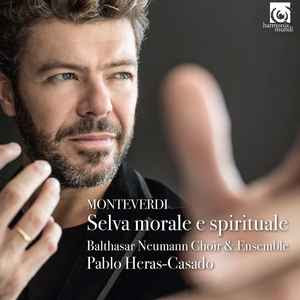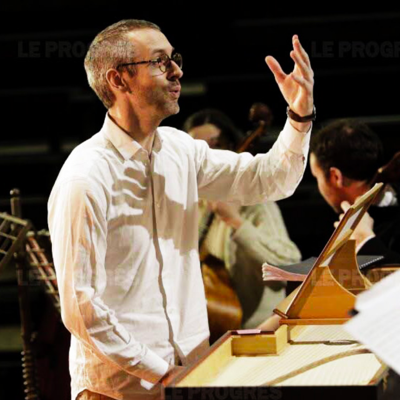Program: #18-18 Air Date: Apr 23, 2018
To listen to this show, you must first LOG IN. If you have already logged in, but you are still seeing this message, please SUBSCRIBE or UPGRADE your subscriber level today.
A young ensemble in an Italian garden, sacred music of Monteverdi, and Charpentier’s journey into hell with Orpheus.
I. Un jardin à l’italienne (Les Arts Florissants/William Christie). Harmonia Mundi CD HAF 8905283.

William Christie and Paul Agnew, the co-directors of the Academy, are well known as fine teachers and indefatigable talent-spotters. Here they present six promising young singers, hitherto unknown to the general public, who were auditioned and recruited from almost 200 candidates.
"Love, hatred, jealousy, disenchantment and wrath are expressed by turns in 'Orlando furioso', probably the most influential text of that period. De Wert's madrigal 'Queste non son più lagrime' borrows lines from Ariosto's masterpiece, while Handel's Orlando and Vivaldi's Orlando furioso, excerpts from which are presented here, both take inspiration from it. If the first part of our recording describes the expressive powers of early Baroque, the second part is a light.
|
Banchieri:
|
Già che ridotti siamo
|
|
Cimarosa:
|
Vè che matta, maledetta! (from L'impresario in angustie)
|
|
Handel:
|
Ah Stigie larve! (from Orlando)
Lascia la spina (from Il Trionfo del Tempo e del Disinganno)
|
|
Haydn:
|
Scellerata! mancatrice! traditrice! (from La Canterina)
Son confuso e stupefatto (from Orlando paladino)
|
|
Sarro:
|
L'impresario delle Canarie, Intermezzi I & II
|
|
Stradella:
|
Amanti olà, olà!
|
|
Vecchi:
|
Fate Silentio
|
|
Vivaldi:
|
Ah sleale, ah spergiura...Io getto elmo, ed usbergo (from Orlando Furioso)
Gelosia, tu già rendi l’alma mia from Ottone in villa
Care pupille (from Tigrane)
|
|
Wert:
|
Queste non son più lacrime
|
:format(jpeg):mode_rgb():quality(40)/discogs-images/R-11352122-1514806864-3329.jpeg.jpg) I
IFraming the disc are the mighty Dixit Dominus secondo and the Magnificat primo – two works calculated to show off the force of the Balthasar Neumann musicians in full spate. Skimming the hairpin bends of Monteverdi’s shifting tempos, Heras-Casado delivers energised, highly rhythmic performances that always look and lean forwards to the next episode. He’s helped by superb engineering, which allows the instrumental forces to glow bright above the voices, the cornetts carving firework-like trails against the rich choral backdrop.
Speeds are swift and dances light, lending real urgency to the joyful works. Jubilet tota civitas for solo soprano and the soprano duet Ut queant laxis positively groove with delight, while the Et resurrexit struggles endearingly to contain its excitement. But while everything is nuanced, correct and very glossy indeed, there’s perhaps just a little too much uniformity, too much politeness to capture the true spirit of Monteverdi. Some rougher edges and a less controlled choral sound would give us those madrigalian colours that never sit far below the surface, even in the sacred music
Framing the disc are the mighty Dixit Dominus secondo and the Magnificat primo – two works calculated to show off the force of the Balthasar Neumann musicians in full spate. Skimming the hairpin bends of Monteverdi’s shifting tempos, Heras-Casado delivers energised, highly rhythmic performances that always look and lean forwards to the next episode. He’s helped by superb engineering, which allows the instrumental forces to glow bright above the voices, the cornetts carving firework-like trails against the rich choral backdrop.
Speeds are swift and dances light, lending real urgency to the joyful works. Jubilet tota civitas for solo soprano and the soprano duet Ut queant laxis positively groove with delight, while the Et resurrexit struggles endearingly to contain its excitement. But while everything is nuanced, correct and very glossy indeed, there’s perhaps just a little too much uniformity, too much politeness to capture the true spirit of Monteverdi. Some rougher edges and a less controlled choral sound would give us those madrigalian colours that never sit far below the surface, even in the sacred music.
| 1 | Dixit Dominus Secondo à 8 Voci Concertato Con Gli Stessi Istromenti Del Primo & Nel Medesimo Modo | 7:47 |
| 2 | Confitebor Secondo à 3 Voci Concertato Con Due Violini | |
| 3 | Iste Confessor Primo Sopra Ad Una Medesima Aria | 2:30 |
| 4 | O Ciechi, Ciechi Madrigale Morale à 5 Voci & Due Violini | 3:05 |
| 5 | Jubilet Tota Civitas à Voce Sola In Dialogo | 4:19 |
| 6 | Salve Regina à 3 Voci, Alto, Basso E Tenore O Soprano | 6:06 |
| 7 | Laudate Pueri Dominum Primo à 5 Concertato Con Due Violini | 6:45 |
| 8 | Laudate Dominum Terzo à 8 Voci | 4:06 |
| 9 | Ut Queant Laxis Sopra Lo Stesso Metro | 3:00 |
| 10 | Crucifixus à Quatro Voci, Basso, Tenore, Quinto & Alto | 2:09 |
| 11 | Et Resurrexit à Due Soprani O Tenori Con Due Violini | 1:28 |
| 12 | Et Iterum à 3 Voci, Basso & Due Contralti, Concertato Con Quattro Tromboni O Viole Da Brazzo Quali Si Ponno Anco Lasciare | 1:26 |
| 13 | Voi Ch'ascoltate Madrigale Morale à 5 Voci & Due Violini | 4:34 |
| 14 | Salve Regina à 2 Voci, Due Tenori O Due Soprani | 5:54 |
| 15 | Magnificat Primo à 8 Voci & Due Violini & Quattro Viole Overo Quattro Tromboni Quali In Acidente Si Ponno Lasciare | 12:27 |
III. La Descente d’Orpheé aux Enfers (Ensemble Correspondances/ Sébastien Daucé). Harmonia Mundi CD HMM 902279.

Composer Info
Banchieri, Cimarosa, Handel, Haydn, Sarro, Monteverdi, Marc-Antoine Charpentier (1643-1704)
CD Info
CD HAF 8905283, CD HMM 902355, CD HMM 902279.
